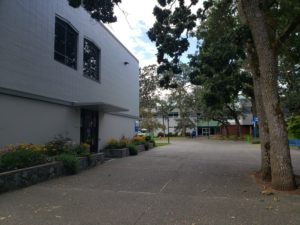Camosun College instructor Micaela Maftei knows a thing or two about mythos, and her students do now too. Every year, Camosun students write and edit the Beside the Point literary journal, which has a different theme every issue. This year’s theme, mythos, stumped a few writers and editors but Maftei noticed this sparked a lot of great conversations between students.
“We talked a lot about how mythos speaks to the importance of storytelling and the way stories, especially stories that get passed down, and different iterations over the years, can be guiding forces, can be full of symbolism and imagery that helps us live our lives,” says Maftei. “A lot of the groups and students talked about how mythos can be deeply personal, like an individual narrative that touches on common themes or familiar patterns but that still stays a personal guiding narrative. So, it’s a kind of storytelling that can guide people, groups, and communities over time.”

Beside the Point will be launched this year at the Wilna Thomas building on Friday, April 14. The launch—happening from 5:30 to 7:00 in room 224—will feature readings of a few select stories, along with snacks and beverages; copies of the journal will be available to purchase. This year’s journal includes fiction and non-fiction stories all following the theme. Maftei—who has been the coordinator behind Beside the Point for two years—stresses that while she acts as a mediator, the journal is fully written and published by Camosun students.
“I officially teach Creative Writing 159, which is the class that puts the journal together. And I see my role in the journal as a bit more of a facilitator,” says Maftei. “So, what I do is I run students through the schedule that we have to follow, and the steps that we take, and I try to teach some skills that they’ll need to put in place, like editing skills and proofreading, and things to think about as they’re doing the tasks. But the students are responsible for the tasks themselves.”
Creative Writing 159 student Micah James assisted in the writing and publishing of the journal this year. She admits that working on the publication was an intimidating task when she started.
“As a student, I’ll be honest, it was a bit of a daunting task at first, to make a publication from the ground up, having never done that before. I’m sure no one in the class has done that; that’s why they’re taking it,” says James. “It was really interesting. Compared to other classes, it needs a lot more group work than individual.”
While group work can sometimes cause contention, James believes the class promotes a positive learning environment that is both professional and communicative.
“Our group is really cohesive, we communicated really well,” says James. “It was interesting because a lot of us were authors, so we could communicate on that level, but also just learning how to look at work professionally, I guess—taking everything as it came and treating each other with respect, no matter what level of writing or anything [a student is at]. We’re all learning the new skill together.”
Maftei explains that the differences in understanding of this year’s theme created variety in the journal.
“There’s a piece that brings in figures from all sorts of religious mythology from various religions, and then there’s other pieces that are really all about a personal code or guiding force,” says Maftei. “There’s a real breadth of understandings of this theme, whether it’s personal, or more of a group mythology, or historical, or contemporary, but they all share this element of using storytelling to understand one’s position and the way forward in life.”
Looking back on her time working on the journal, James thinks that the process offered a lot of insight into the inner workings of writing and editing and what it takes to have a piece of work published.
“I think my biggest takeaway is just how much goes on behind the scenes of making a book,” says James. “Of course, a lot of us read and some of us write but it’s a lot more kind of mystical: what goes on behind the scenes and how to get on the shelves. So even though this was really small scale, doing this, I think it was really interesting to see just how much work goes in behind that, with just reading every piece for the millionth time, checking for small things or big overarching [things]. It’s really insightful, just in general, but also as an author to see how you’re a part of that whole process.”
